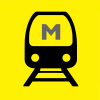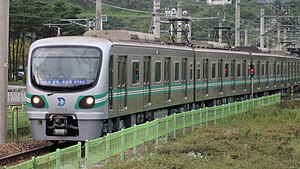Daegu Metro (Korean: 대구도시철도; Hanja: 大邱都市鐵道; RR: Daegu dosicheoldo) is a metro system that serves primarily the South Korean city of Daegu, operated by Daegu Transportation Corporation from 5:30AM to 0:00AM with the interval from 5 to 8 minutes between each car's arrival.[2] With the fastest track speed at 80 km/h (50 mph), it takes 55 minutes for Line 1 and Line 2, and 48 minutes for Line 3 to reach the terminus station.[2] As of 2015, the number of average daily passengers is 186,992 people for Line 1, 177,984 people for Line 2, and 69,127 people for Line 3.[2]
| Daegu Metro | |||
|---|---|---|---|
 | |||
 Daegu Metro Line 2 | |||
| Overview | |||
| Owner | City of Daegu | ||
| Locale | Daegu, South Korea | ||
| Transit type | Rapid transit and Monorail | ||
| Number of lines | 2 rapid transit 1 monorail | ||
| Number of stations | 60 (rapid transit only)[1] 90 (incl. monorail) | ||
| Operation | |||
| Began operation | 26 November 1997 | ||
| Operator(s) | Daegu Transportation Corporation | ||
| Number of vehicles | Rapid transit train and monorail | ||
| Technical | |||
| System length | 59.8 km (37.2 mi) (rapid transit only)[1] 83.7 km (52.0 mi) (incl. monorail) | ||
| Track gauge | 1,435 mm (4 ft 8+1⁄2 in) (rapid transit only) | ||
| |||
| Daegu Metro | |
| Hangul | 대구도시철도 |
|---|---|
| Hanja | |
| Revised Romanization | Daegu dosicheoldo |
| McCune–Reischauer | Taegu tosich'ŏlto |

History
editThe construction of Daegu Metro was recommended to the city after the City of Daegu conducted the research in 1985 to find the ways to improve the city's transit. Following the establishment of the committee to oversee the new metro transit construction in September 1989, the study was conducted from 1989 to 1990 to evaluate whether the construction project was feasible.[2] The guidelines for the metro transit's construction and operation was approved in January 1991. While the guideline focused on solving the traffic issues due to the overpopulation of the downtown area, it set the consequent goals of improving the city with more efficiency resulting from shorter commuting times, cleaner environment with reduced auto traffic and energy expense, larger outreach to bring the transit to those outside the urban area, and improved transportation capacity.[2]
Line 1
editThe construction of Daegu Metro Line 1 began in December 1991 and the first 10.3 km long section between Jincheon and Jungang-ro began on November 26, 1997. After the second 24.9 km (15.5 mi) long section of Line 1 between Jincheon and Ansim opened on May 2, 1998, the extension was made to Daegok towards south in May 2002. The southern extension was made from Daegok to Seolhwa in 2016, making Line 1 28.4 km (17.6 mi) long with 32 stations. The most recent extension was made in December 2024 from Ansim to Hayang, making Line 1 37.1 km (23.1 mi) long with 35 stations. The line serves its function to connect the southwestern area of the downtown to the city's east.[2]
Line 2
editThe construction of Line 2 began in December 1996 and was completed on October 18, 2005, with the 28.0 km (17.4 mi) long section between Munyang and Sawol. In June 2007, the line was extended to connect the three newly built metro stations in the neighboring city of Gyeongsan. Another construction to add the 3.3 km (2.1 mi) long section to the line from Sawol to Yeungnam University of Gyeongsan was completed in September 2012. As of now, the line is 31.4 km (19.5 mi) long with 29 stations.[2]
Line 3
editThe construction of Line 3 was completed between Gyeongbook University Hospital's Chilgok campus and Yongji on May 17, 2009. The most recent extension was made on April 23, 2015, with the entire line being 23.1 km (14.4 mi) long with 30 stations. Being operated as a light rail system with monorails, the line is also commonly referred as Sky Rail.
Future plans
editThe transport department has approved the plan to build the Automated Guideway Transit line in Daegu. The color of AGT line will be purple.
Lines
edit| Line Name English |
Line Name Hangul |
Starting Station(s) | Ending Station(s) | Stations | Total Length (km) |
|---|---|---|---|---|---|
| Rapid transit: | |||||
| 1호선 | Seolhwa-Myeonggok | Hayang | 35[1] | 37.1[1] | |
| 2호선 | Munyang | Yeungnam Univ. | 29[1] | 31.4[1] | |
| Monorail: | |||||
| 3호선 | Chilgok Kyungpook Nat'l Univ. Medical Center | Yongji | 30 | 23.9 | |
| Commuter rail: | |||||
| Daegyeong Line | 대경선 | Gumi | Gyeongsan | 10 | 61.8[3] |
Fare
editThe fare is 1,400 won for a token to any stop on the subway and 1,250 won with the use of a transportation card.
Rolling stock
editDaegu Metro lines are segregated, each with its own distinct vehicles. Lines 1 and 2 use the same railway technology (rapid transit), while Line 3 uses an entirely different system (monorail).
| Line | Manufacturer (country of origin) | Model | Type | No. car sets ( No. of cars) |
|---|---|---|---|---|
| Line 1 | Hanjin Heavy Industries (Hanjin Transportation) ( South Korea) | 1000-series | metro cars | 63 (216) |
| Line 2 | Hyundai Rotem ( South Korea) | 2000-series | metro cars | 30 (180) |
| Line 3 | Hitachi Transportation Systems Korea ( Japan / South Korea) Woojin Industrial System Company Limited ( South Korea) |
3000-series | straddle-beam monorail | 28 (84)[4] |
Accidents and incidents
editOn 28 April 1995, a gas explosion occurred during the construction of Line 1 near the District of Sangin. 101 people near the site, including 53 students, were killed and 143 people were injured.[5]
On 18 February 2003, the Daegu subway fire broke out when an arsonist set fire to a train during the rush hour, killing 192 people and injuring 148 people.[6] The incident raised great concerns and consequent awareness in the public safety of the metro transit, prompting the city to replace the subway car's internal materials to be more flame retardant, placing the emergency gas masks and respirators within the subway cars, and improving the safety guidelines.[7]
In December 2008, the Daegu Safety Theme Park opened with the goal to educate and raise awareness of the public metro safety to the city's people as well as visitors.[8]
Network map
edit
See also
editReferences
edit- ^ a b c d e f "Overview > Company Information > Operation System". Daegu Metropolitan Transit Corporation. Archived from the original on 23 September 2015. Retrieved 22 April 2015.
- ^ a b c d e f g "대구지하철(大邱地下鐵)". Academy of Korean Studies.
- ^ "Gumi-Daegu-Gyeongsan Line to Open tomorrow". YTN. 13 December 2024. Retrieved 14 December 2024.
- ^ "Daegu Urban Railway Line 3". Railway Technology. Verdict Media Limited.
- ^ "어째서 또 이런일이... 大邱 가스폭발 百여명 사망" (Press release). Kyunghyang Shinmun. 29 April 1995. Retrieved 17 August 2015.
- ^ Kirk, Don (27 February 2003). "Subway fire toll rises much higher". International Herald Tribune. Archived from the original on 27 October 2005.
- ^ Jo, Jeonghoon (22 February 2013). "대구지하철, 인력 줄어 또 사고날 수도". OhmyNews.
- ^ "Daegu Safety Theme Park (대구시민안전테마파크)". Official Korea Tourism Organization. Retrieved 1 June 2018.
External links
edit- Daegu Transportation Corporation – official website (in English)
- Daegu at UrbanRail.net (in English)
